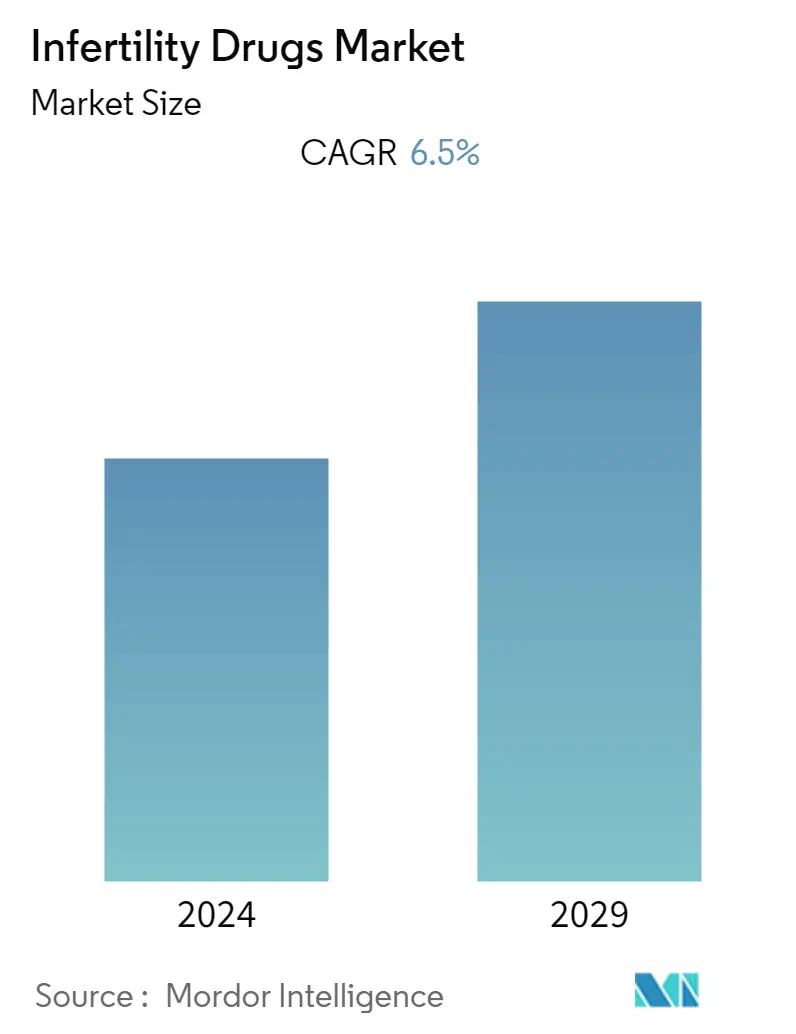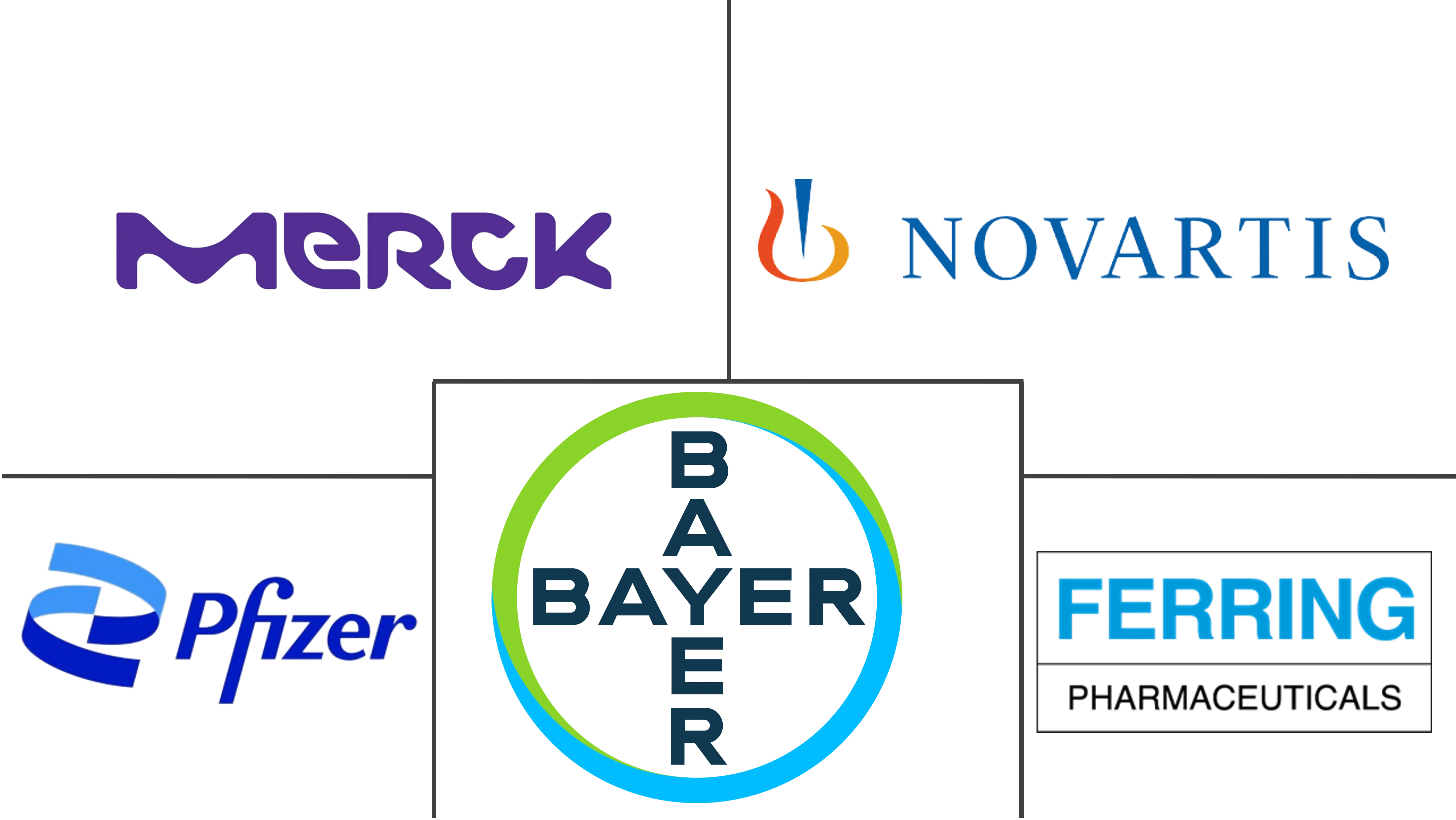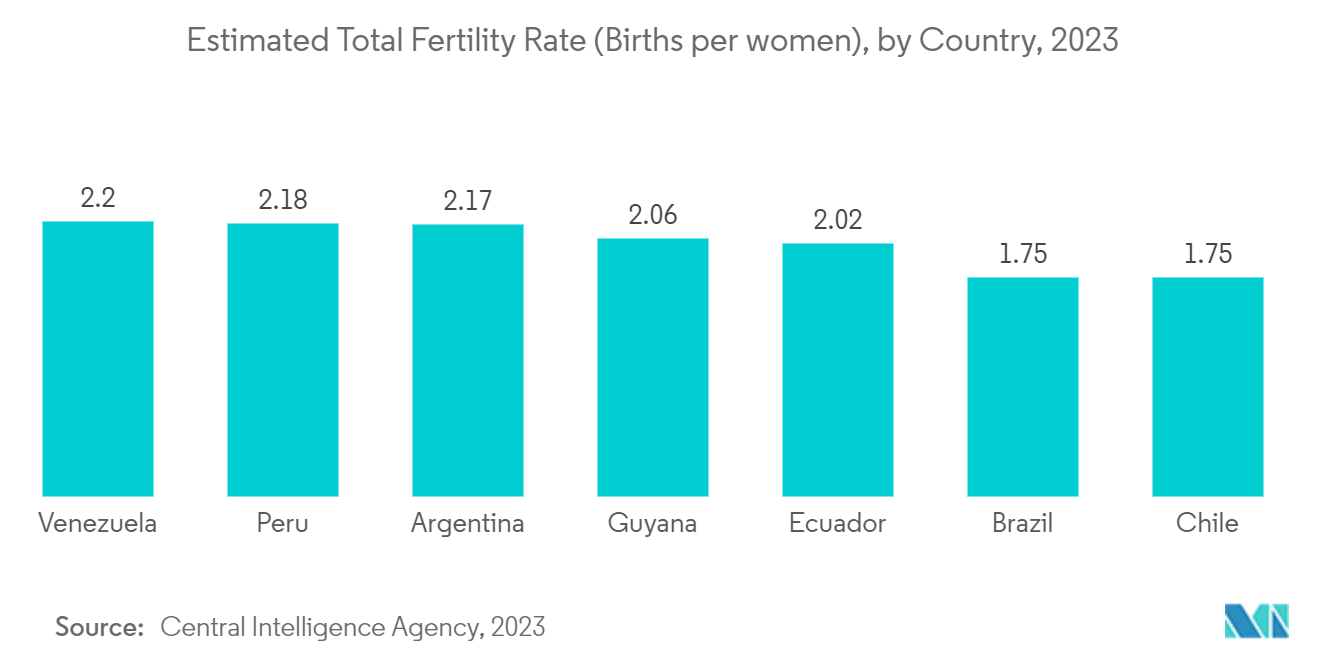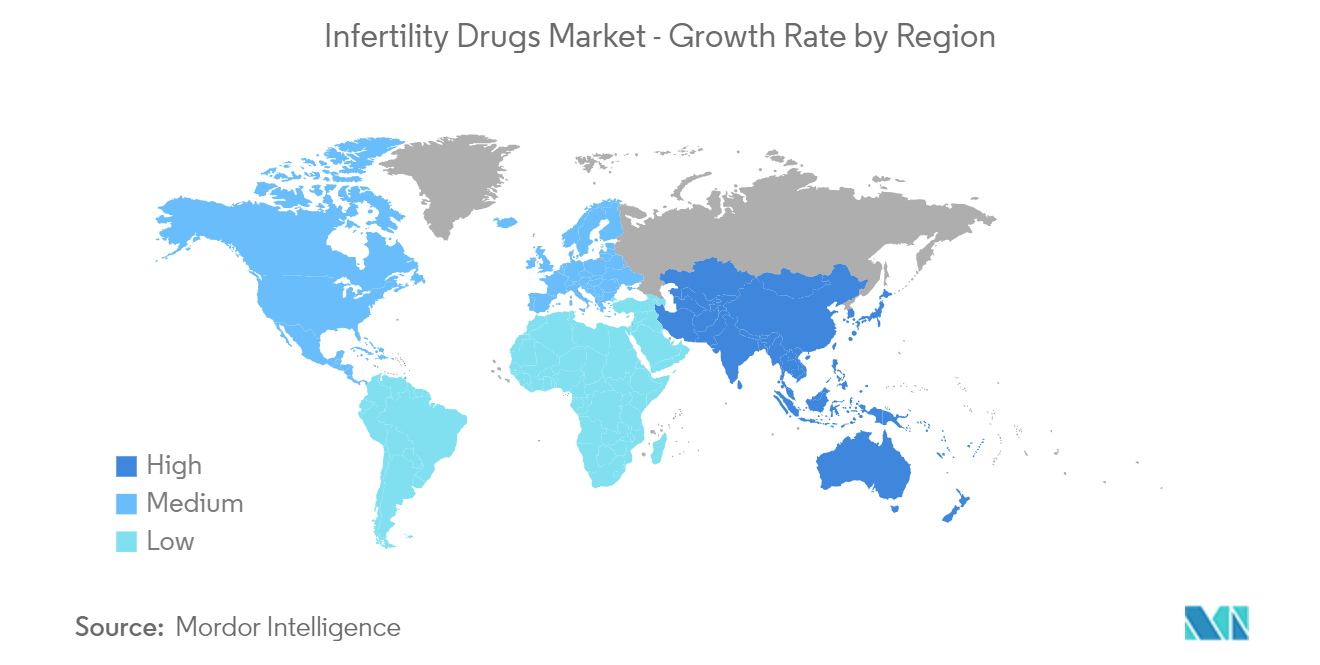Infertility Drugs Market Size

| Study Period | 2019 - 2029 |
| Base Year For Estimation | 2023 |
| CAGR | 6.50 % |
| Fastest Growing Market | Asia Pacific |
| Largest Market | North America |
| Market Concentration | Medium |
Major Players
*Disclaimer: Major Players sorted in no particular order |
Infertility Drugs Market Analysis
The infertility drugs market is expected to register a CAGR of 6.5% over the forecast period.
The outbreak of COVID-19 adversely impacted the market. The disruption in the supply chain during COVID-19 and the delay in the delivery of essential products required for the manufacturing of infertility drugs adversely affected the infertility drugs market. Also, suspending fertility centers to avoid coronavirus transmission among the population impacted the market growth. For instance, according to an article published in the National Library of Medicine in April 2021, it was observed that reproductive therapy was suspended during the pandemic's initial phase, creating anxiety and psychological suffering among women undergoing fertility treatment. Additionally, according to an article published in the Annals of Medicine and Surgery in June 2022, it was found that in-vitro fertilization cycles were discontinued due to patients testing positive for COVID-19 in Indonesia. Thus, such suspended procedures impacted the demand for infertility drugs during the pandemic. However, with the released restrictions and resumed fertility treatment services and centers, the studied market witnessed significant growth in the demand for infertility drugs owing to the increased number of people's visits to fertilization centers.
Factors such as the increasing global prevalence of stress and lifestyle-related disorders among men and women, the rise in healthcare awareness, and the increasingly aging female population are expected to boost the market growth.
Infertility continues to pose a global health challenge owing to demographic shifts and continuous lifestyle problems, including obesity, anxiety, stress, and other factors that cause delayed childbearing. For instance, according to the data published by Alcoholic Beverage Consumption Statistics published in February 2023, about 63% of adults in the United States who were 18 or older drank alcohol during 2021-2022. Additionally, as per the data published in Alcohol Consumption Statistics United Kingdom in February 2023, it was observed that 12.5% of adults in the United Kingdom reported being teetotal, compared to the country's adult alcohol consumption rate of 71.2% who drink at least once a week. Thus, the high consumption of alcohol affects fertility in both males and females. It, in turn, is anticipated to fuel the demand for infertility drugs over the forecast period.
The prevalence of poor fertility among the population is also the key factor driving the market growth. For instance, according to an article published by the National Library of Medicine, in July 2022, about 15% of American couples and at least 180 million other people worldwide suffer from infertility. Also, it is estimated that 9% of Australian men and 8% to 12% of Eastern European men experience infertility issues. Thus, the high prevalence of infertility among men population across the globe is expected to increase the demand for effective drugs, thereby propelling market growth.
Furthermore, the increasing government and organization focus on launching various campaigns to raise awareness regarding fertility care and treatment and the factors that cause infertility problems among the population. For instance, in July 2022, Oasis Fertility launched the Infertility Knows No Gender campaign to commemorate World IVF Day. IVF offers a ray of hope to millions of couples struggling with infertility. Also, in April 2022, Walgreens launched a fertility awareness campaign in support of National Infertility Awareness Week. Such initiatives are anticipated to raise the demand for IVF treatment, which is anticipated to fuel the market growth over the forecast period.
Therefore, the studied market is expected to grow over the forecast period due to the factors above, such as the high prevalence of poor fertility, increasing sedentary lifestyle, and a growing number of awareness campaigns. However, the stringent regulatory framework for drug approval will likely impede the growth of the infertility drugs market over the forecast period.
Infertility Drugs Market Trends
Gonadotrophins Segment is Expected to Witness Growth Over the Forecast Period
Gonadotrophins are hormones that the anterior pituitary produces and releases. They act on the gonads (testes and ovaries) to boost the production of sex hormones and encourage either ova or sperm production. Gonadotrophins are a component of fertility treatments that help women induce ovulation and develop mature follicles. In men, it boosts sperm counts during fertility treatment. Follicle-stimulating hormone (FSH) and luteinizing hormones (LH) are the main gonadotropins. Some gonadotrophins available in the market are chorionic gonadotrophin (hcg), Pregnyl, Gonal-f, Ovidrel, Menopur, Novarel, Follistim, and others.
The gonadotrophin segment is anticipated to witness significant growth in the infertility drugs market over the forecast period owing to factors such as the high efficacy of gonadotrophins to treat infertility issues among the population and new product launches. For instance, according to an article published in Cell in May 2022, it was observed that male infertility is an increasing and serious medical concern that affects approximately half of infertile couples worldwide. Also, an article published in the International Bar Association in March 2022 showed that fertility rates consistently declined to below replacement levels across developed countries globally. It is anticipated to fuel the demand for drugs to treat infertility problems, propelling the segment's growth.
Furthermore, the increasing number of research studies related to gonadotropin drugs is also contributing to segment growth. For instance, as per an article published in the Reproductive Biology and Endocrinology in July 2021, a study was conducted to compare the effectiveness of recombinant human follicle-stimulating hormone alfa (r-hFSH-alfa; GONAL-f) with urinary highly purified human menopausal gonadotropin (hMG HP; Menogon HP), during assisted reproductive technology (ART) treatments in Germany. It was observed that the cycles stimulated with r-hFSH-alfa exhibited higher cumulative live birth rate (LBR), clinical pregnancy rate (CPR), and ongoing pregnancy rate (OPR), as well as lower cancellation rates and gonadotropin usage per oocyte retrieval as compared to hMG HP. Thus, the high effectiveness of -hFSH-alfa is expected to increase its adoption among users for treating infertility cases, which is anticipated to boost the segment growth over the forecast period.
Moreover, the rising number of new product launches increases the availability of effective drugs in the market. For instance, in August 2021, Merck launched the Pergoveris Pen for fertility treatment in India. The product combines recombinant follicle-stimulating and luteinizing hormones in a ready-to-use device. It enables individuals to be treated by an IVF specialist for severe FSH and LH deficits for a better experience.
Therefore, owing to the factors above, such as the high prevalence of infertility cases, the rising number of research studies, and new product launches, the studied segment is anticipated to grow over the forecast period.

North America is Expected to Hold the Significant Market Share Over the Forecast Period
North America is anticipated to hold a significant share of the market due to rising incidences of infertility problems, menopausal disorders, urinary infections, thyroid problems, endometriosis, and others due to busy lifestyles and a rise in stress among women. In addition, increasing demand for more advanced infertility drugs and growing company activities are also contributing to the market growth.
The number of male fertility cases is rising due to increased levels of smoking, consumption of alcohol, use of certain illicit drugs, and underlying conditions such as obesity. For instance, an article published by StatPearls in July 2022 found that the estimated male infertility rate is between 4.5% and 6% in North America. Also, as per the 2021 data published by the WHO, 12% of the people in Canada smoke regularly, and people aged 20 years or above hold the highest rate of smoking (11%) as compared to people aged 15 years to 19 years (4%). The rising prevalence of smoking is associated with a high level of ferroptosis in seminal plasma, which affects the quality of semen and lowers the probability of getting pregnant, which is expected to propel the growth of the studied market over the forecast period.
Furthermore, the increasing government and company initiatives to promote fertility treatment are also contributing to the high demand for fertility drugs in the market. For instance, in November 2021, EMD Serono launched its enhanced Fertility LifeLines patient support program based on feedback from reproductive health medical professionals and patients on their fertility journey in Canada. Such initiatives are expected to raise awareness among the population regarding fertility treatment, which is anticipated to fuel market growth.
Therefore, owing to the factors above, the studied market is anticipated to grow over the forecast period.

Infertility Drugs Industry Overview
The infertility drugs market is moderately competitive and consists of several major players. Some of the key companies in the market are Ferring Pharmaceuticals Inc., Pfizer Inc., Merck KGaA, Bayer AG, Takeda Pharmaceutical Company Limited, and Novartis AG, among others.
Infertility Drugs Market Leaders
-
Ferring Pharmaceuticals Inc
-
Pfizer Inc.
-
Merck KGaA
-
Novartis International AG
-
Bayer AG
*Disclaimer: Major Players sorted in no particular order

Infertility Drugs Market News
- February 2023: Russia started producing recombinant follicle-stimulating hormone in-house, including two other IVF drugs. In addition, the company plans to produce human chorionic gonadotropin hormone using biotechnology to overcome the shortage of raw materials.
- August 2022: The United States FDA approved Akorn Operating Company's cetrorelix acetate for injection, a generic Cetrotide, to prevent early luteinizing hormone surges in females undergoing controlled ovarian stimulation.
Infertility Drugs Market Report - Table of Contents
1. INTRODUCTION
- 1.1 Study Assumptions and Market Defination
- 1.2 Scope of the Study
2. RESEARCH METHODOLOGY
3. EXECUTIVE SUMMARY
4. MARKET DYNAMICS
- 4.1 Market Overview
-
4.2 Market Drivers
- 4.2.1 Increasing Global Prevalence of Stress and Life-style Disorders among Men and Women
- 4.2.2 Rise in Healthcare Awareness along with Increasing Aging Female Population
-
4.3 Market Restraints
- 4.3.1 Stringent Regulatory Framework that Delays the Approval of Products
-
4.4 Porter's Five Forces Analysis
- 4.4.1 Bargaining Power of Suppliers
- 4.4.2 Bargaining Power of Buyers/Consumers
- 4.4.3 Threat of New Entrants
- 4.4.4 Threat of Substitute Products
- 4.4.5 Intensity of Competitive Rivalry
5. MARKET SEGMENTATION (Market Size by Value - USD)
-
5.1 By Drug Class
- 5.1.1 Gonadotrophins
- 5.1.2 Aromatase Inhibitors
- 5.1.3 Selective Estrogen Receptor Modulators (SERMs)
- 5.1.4 Biguanides
- 5.1.5 Other Drug Classes
-
5.2 By End User
- 5.2.1 Male
- 5.2.2 Female
-
5.3 By Distribution Channel
- 5.3.1 Hospital Pharmacies
- 5.3.2 Retail Pharmacies
- 5.3.3 Other Distribution Channels
-
5.4 Geography
- 5.4.1 North America
- 5.4.1.1 United States
- 5.4.1.2 Canada
- 5.4.1.3 Mexico
- 5.4.2 Europe
- 5.4.2.1 Germany
- 5.4.2.2 United Kingdom
- 5.4.2.3 France
- 5.4.2.4 Italy
- 5.4.2.5 Spain
- 5.4.2.6 Rest of Europe
- 5.4.3 Asia-Pacific
- 5.4.3.1 China
- 5.4.3.2 Japan
- 5.4.3.3 India
- 5.4.3.4 Australia
- 5.4.3.5 South Korea
- 5.4.3.6 Rest of Asia-Pacific
- 5.4.4 Middle East and Africa
- 5.4.4.1 GCC
- 5.4.4.2 South Africa
- 5.4.4.3 Rest of Middle East and Africa
- 5.4.5 South America
- 5.4.5.1 Brazil
- 5.4.5.2 Argentina
- 5.4.5.3 Rest of South America
6. COMPETITIVE LANDSCAPE
-
6.1 Company Profiles
- 6.1.1 Abbott Laboratories
- 6.1.2 Ferring Pharmaceuticals Inc.
- 6.1.3 Merck KGaA
- 6.1.4 Pfizer Inc.
- 6.1.5 Novartis International AG
- 6.1.6 Bayer AG
- 6.1.7 Theramex
- 6.1.8 Mankind Pharma
- 6.1.9 Teva Pharmaceticals Industries
- 6.1.10 Livzon
- *List Not Exhaustive
7. MARKET OPPORTUNITIES AND FUTURE TRENDS
** Subject To AvailablityInfertility Drugs Industry Segmentation
As per the scope of the report, infertility is the inability of a woman to become pregnant after one year (or longer) of unprotected sex. The fertility rate decreases with age 35 or above in both men and women. Medicines that regulate or stimulate ovulation are known as fertility drugs. Fertility drugs are the main treatment for infertile women due to ovulation disorders. Fertility drugs generally work with natural hormones, such as follicle-stimulating hormone (FSH) and luteinizing hormone (LH), to trigger ovulation. The Infertility Drugs Market is segmented by drug class (gonadotrophins, aromatase inhibitors, Selective Estrogen Receptor Modulators (SERMs), biguanides, and other drug classes), end user (male and female), distribution channel (hospital pharmacies, retail pharmacies, and other distribution channels), and Geography (North America, Europe, Asia-Pacific, Middle East and Africa, and South America). The report also covers the estimated market sizes and trends for 17 countries across major regions globally. The report offers the value (in USD) for the above segments.
| By Drug Class | Gonadotrophins | |
| Aromatase Inhibitors | ||
| Selective Estrogen Receptor Modulators (SERMs) | ||
| Biguanides | ||
| Other Drug Classes | ||
| By End User | Male | |
| Female | ||
| By Distribution Channel | Hospital Pharmacies | |
| Retail Pharmacies | ||
| Other Distribution Channels | ||
| Geography | North America | United States |
| Canada | ||
| Mexico | ||
| Geography | Europe | Germany |
| United Kingdom | ||
| France | ||
| Italy | ||
| Spain | ||
| Rest of Europe | ||
| Geography | Asia-Pacific | China |
| Japan | ||
| India | ||
| Australia | ||
| South Korea | ||
| Rest of Asia-Pacific | ||
| Geography | Middle East and Africa | GCC |
| South Africa | ||
| Rest of Middle East and Africa | ||
| Geography | South America | Brazil |
| Argentina | ||
| Rest of South America |
Infertility Drugs Market Research FAQs
What is the current Global Infertility Drugs Market size?
The Global Infertility Drugs Market is projected to register a CAGR of 6.5% during the forecast period (2024-2029)
Who are the key players in Global Infertility Drugs Market?
Ferring Pharmaceuticals Inc, Pfizer Inc., Merck KGaA, Novartis International AG and Bayer AG are the major companies operating in the Global Infertility Drugs Market.
Which is the fastest growing region in Global Infertility Drugs Market?
Asia Pacific is estimated to grow at the highest CAGR over the forecast period (2024-2029).
Which region has the biggest share in Global Infertility Drugs Market?
In 2024, the North America accounts for the largest market share in Global Infertility Drugs Market.
What years does this Global Infertility Drugs Market cover?
The report covers the Global Infertility Drugs Market historical market size for years: 2019, 2020, 2021, 2022 and 2023. The report also forecasts the Global Infertility Drugs Market size for years: 2024, 2025, 2026, 2027, 2028 and 2029.
UK Neurology Devices Industry Report
Statistics for the 2024 UK Neurology Devices market share, size and revenue growth rate, created by Mordor Intelligence™ Industry Reports. UK Neurology Devices analysis includes a market forecast outlook 2029 and historical overview. Get a sample of this industry analysis as a free report PDF download.



